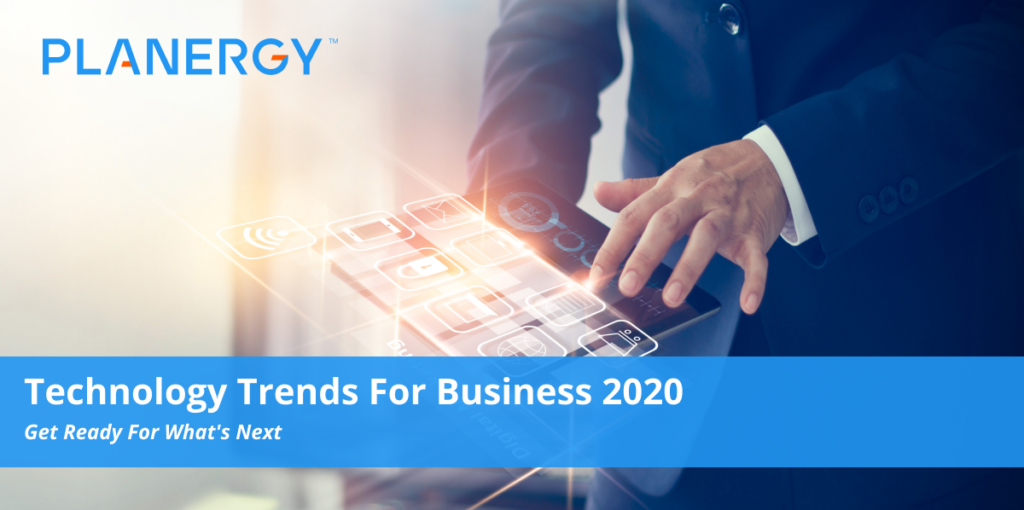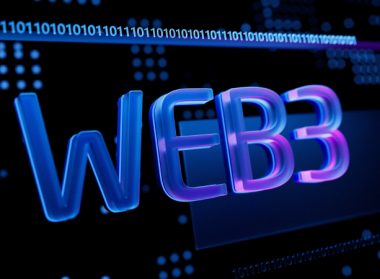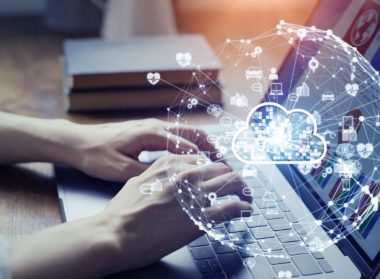With digital transformation becoming an increasingly important part of success for organizations looking to compete in the global marketplace, staying on top of the latest technology trends for business is no longer optional.
As groundbreaking technologies emerge and evolve into “the new normal,” savvy small businesses and forward-thinking conglomerates alike shift their focus to turning business technology trends into competitive advantage, better decision making, and more efficient and effective workflows.
New technologies continue to blur the line between the digital realm and the physical world.
For those looking to make new technologies part of their business strategy today (and in the coming years), navigating this brave new blended world begins with identifying and understanding the emerging trends dominating the headlines and boardrooms around the globe.
Zooming in on 2020’s Most Important Technology Trends for Business
One of the biggest challenges of doing business in the age of Big Data and digital transformation is finding effective ways to filter out the most useful bits floating in the torrent of information flooding our news, social media, and industry communications and determine which hot new business technology trends are the real deal, and which are mere flotsam.
Every business is different, and not every trend will have equal potential or usability for any given business.
Trends such as autonomous vehicles will have special appeal to logistics firms and auto livery specialists such as Uber and Lyft, for example.
On the other hand, advertisers and marketing firms, as well as social media giants and government organizations, are deeply interested in advanced profiling tools.
Capable of delving deeply into an individual’s social media, eCommerce, and online communication, these tools can analyze and leverage a person’s activity data to create increasingly sophisticated profiles that can be used to create everything from intimately personalized advertisements to 3D-printed, customized razor handles.
And speaking of 3D printing, medical professionals and manufacturers will likely take a much greater interest in that particular technology in 2020 and beyond.
In perhaps the ultimate upgrade to the “customer experience,” current 3D research is developing new ways to “print” eyes, ears, and other organs, and enhancements to others, using a mix of synthetic materials and printed living tissue.
In fact, it’s possible to find technology trends that speak to the very specific interests of just about any industry, market, or company.
However, a certain set of emerging technologies has value for just about everyone doing business in today’s market, from small business owners to CEOs.
In 2020, IoT applications will likely expand to include even more powerful tools, including not just remote monitoring, but manipulation of IoT devices through the Internet using an app.
2020’s Top Six Technology Trends for Business
No two businesses are ever 100% alike, and every company and organization will have its own priorities, goals, and specific issues with risk, compliance, etc. when prioritizing the importance of tech trends.
That said, six of 2020’s most exciting and powerful tech trends have the potential to help just about any business improve their productivity, profitability, and competitive performance.
1. Artificial Intelligence (AI)
AI’s been thrown around as a buzzword for decades. But as machine learning becomes more sophisticated, and artificial intelligence applications become more and more integrated with the existing dataspheres of companies across the world, the role of artificial intelligence is expanding exponentially.
Many people associate the concept of artificial intelligence with the use of physical entities like drones and robots.
For example, companies such as Amazon, Dominos, and Kroger have already begun to experiment with delivery drones powered by artificial intelligence. Elsewhere, scientists are helping AI to interface with the real world the way humans do by teaching it to race drones.
But for businesses, the value of artificial intelligence lies largely in the intangible. From robotic process automation (RPA), which uses software robots to fully automate (and improve through iterative correction) repetitive, tedious, and high-volume tasks, to data analytics and decision making powered by deep learning, it’s the unseen virtual minds of AI technology, and not physical bodies, that power better business strategies, real-time analytics, and more strategic and profitable business decisions.
AI can also be used to implement processes such as the blockchain into automated business processes, strengthening security and improving performance while freeing staff to focus their skills and attention on higher-value tasks.
This is especially true in areas such as procurement, where process automation and real-time data analysis work in concert with cloud computing and advanced data management to create a collaborative, interconnected hub for all your spend data, activity, and forecasting/reporting.
For companies who want to take advantage of these gains, there’s no time like the present. A 2018 study by research firm Gartner found that 41% of businesses surveyed had already begun to integrate AI and machine learning into their workflows.
2. The Internet of Things (IoT)
Back in the ’90s, all the chief information officers (CIOs) and early adopters were primarily focused on getting antiquated companies up to date by putting them on the Internet.
Today, however, it’s not just companies and their staff logging on, but a whole range of devices that makeup a physical network of Internet-connected objects we call the Internet of Things.
IoT devices cover a very broad range of applications. Internet-connected fridges that tell you when you’re low on milk, Amazon’s “Dash” automated reordering buttons, and all the doorbells, lights, thermostats and other appliances controlled through smartphone apps are all examples of consumer IoT devices.
For businesses, application of interests include:
- Asset tracking tools for improved inventory management (automated scanners on racks and warehouse doors monitor asset activity in real time and feed the data to central servers, while devices attached to the company’s shipping fleet provide real-time location, vehicle health, and overall efficiency data).
- Healthcare and safety monitors worn by employees to track their physical safety and comfort on the job.
- Advanced production feedback monitors that continuously track the efficiency and performance of essential hardware, allowing you to stave off disaster before it can cripple production.
- Integration with inventory, procure-to-pay (P2P), and accounting systems to provide real-time updates on goods ordered, delivered, and paid for.
In 2020, IoT applications will likely expand to include even more powerful tools, including not just remote monitoring, but manipulation of IoT devices through the Internet using an app.
Some cameras, for example, already have this functionality, but in coming years the IoT may include:
- Widespread use of remote diagnosis and treatment for healthcare professionals.
- Integration of IoT with AI to create “smart environments,” where offices, homes, and even entire cities automatically react to meet human needs for comfort and access to services through the combined use of machine learning, automation, and sensor-based data collection and analysis.
- Increasing integration with social media, eCommerce, and other apps to create ever-greater levels of personalization. In the future, businesses may be able to identify a customer as they enter a store, automatically issue a coupon on their favorite items, and send a message with the discount code and a custom map leading directly to the product inside the store.
- Edge computing, which brings advanced data analysis directly to the point of data collection. Because many IoT devices exist at the “edge” of a company’s datasphere and network, having localized analytics can speed reaction times and decision making, particularly for AI-driven business models and industrial applications such as oil & gas facilities management or traffic control. The data can still be sent to cloud-based servers for additional analysis and system updates for other applications, without sacrificing efficiency and speed where it’s needed most.
3. 5G (Finally)
The leap to the fifth generation of cellular network might seem more likely to concern mobile gamers and binge-watchers than CIOs, but this is one upgrade with serious potential for productivity enhancements.
Boasting a capacity more than 1,000 times larger than 4G, and with support for 10 gigabits per second on more than 100 billion devices, 5G is poised to reduce lag and bring reliable Internet access just about everywhere as it rolls out between 2020 and 2030.
As an emerging technology, 5G’s real promise lies in the potential to power an even larger Internet of Things, enhancing real-time collaboration, communication, and asset management, as well as data analysis and strategic decision making.
5G will also support other techs that boost productivity, such as:
- Reliable telecommunication and telecommuting (lowering overhead for buildings, furniture, office supplies, etc.)
- The use of advanced modeling tech such as digital twins in previously inaccessible locations.
- Support for real-time, in situ repairs and maintenance through the use of onsite, Internet-connected 3D printing.
4. A Whole New Kind of Reality
Succeeding in the physical world is often challenging enough for most businesses.
But as the digital realm becomes more entangled with the real one, the blending has produced a new way for humans and machines to share these blurred spaces.
In 2020 and beyond, virtual reality (VR) will continue to be used in new and creative ways by consumers and companies alike.
Prototyping, conference calls, and digital versions of test environments are just a few VR tools at the disposal of forward-thinking companies.
But just as VR gave us a way to step into the digital world, two of its “children” are giving us the tools needed to bring digital assets into the real world.
Both augmented reality (AR) and mixed reality (MR) make it possible to manage real-world devices in a digital environment using (for example) a smartphone app, or manipulate and interact with digital objects in the real world in the same way.
For example, augmented reality can give customers the ability to preview objects in their home before they buy them, or create immersive employee training environments.
Mixed reality can turn a smartphone into a real-time translation tool, as with Google Translate. One day soon, AR may make it possible for digital avatars of remote workers to appear “in person” from around the world, or place a digital copy of themselves in a hazard environment to correct a problem using tech tools, but their own human ingenuity and skill.
5. Enhanced Data Security and Control
The advent of measures such as the European Union’s General Data Protection Regulation (GDPR) is a powerful reflection of a major concern for consumers, businesses, and governments alike: the security and privacy of data.
Increasing cybersecurity is a concern that spans all industries and verticals. It’s not just about protecting intellectual property from cyberattacks, but protecting the financial and personal data entrusted to your company by your customers.
Here, too, AI will play a major role, as software developers integrate the analytical power of artificial intelligence to identify and combat hacking attempts at speeds much faster than humans can manage.
Deep learning can be used to create increasingly complex encryption algorithms, strengthening cybersecurity, thwarting cybercriminals, and reducing the risk of data leaks or breaches.
And, as the Internet of Things grows, so, too, will the need for cybersecurity capabilities within connected devices. Visions of “hacked” autonomous vehicles wreaking havoc aside, businesses have a vested interest in ensuring all their remote sensors, digital twins, and customer experience tools such as chatbots are well-protected to avoid serious and potentially dangerous data disasters.
6. Prioritizing Value Creation
Traditionally, businesses have focused time and attention not related to generating revenue to slashing the costs that shrink it.
But modern business process management shifts the focus away from mere cost savings and toward value creation, and seeks to maximize value through both cost reductions and optimization of business processes.
Tech tools that support this change in focus, such as cloud computing, advanced analytics, artificial intelligence, and process automation, can help a company make the sometimes difficult “digital leap.”
For example, choosing to upgrade to a comprehensive procurement solution like PLANERGY can streamline the process in several key ways:
- Re-centering procurement as a value creation center and source of cost reductions through reduced waste, higher efficiency, and lower Total Cost of Ownership (TCO).
- Establishing a new paradigm for process efficiency that can be applied to other areas, from customer resource management (CRM) to enterprise resource planning (ERP) to accounting, sales, and beyond.
- Centralizing data collection and management for improved collaboration and communication between staff, management, and vendors while still supporting use of IoT tools that rely on edge computing.
- Maximizing staff productivity and efficiency, increasing accountability, and providing human oversight while simultaneously stripping human error and delays from automated processes.
Tap into the Power of Today’s Tech Trends
For businesses seeking an edge in the battle for profits and productivity, the future is already here.
By preparing now for the technologies set to make digital waves in 2020 and beyond, your business will be ready to take full advantage of their promise, and generate the profits, competitive performance, and process improvements that will help you tackle the challenges that await beyond the current tech horizon.Fthe




